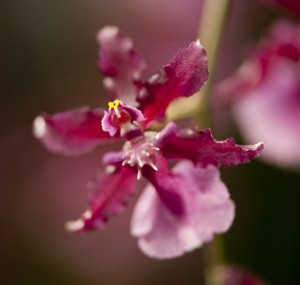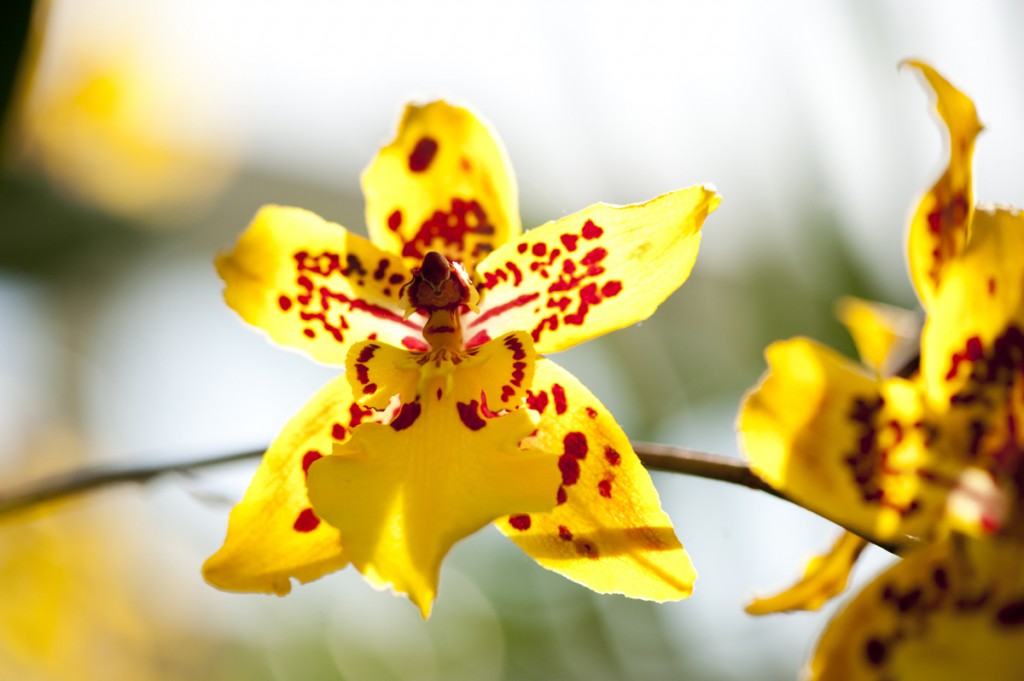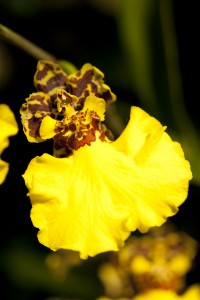Dancing Ladies
Posted in Horticulture on February 25 2015, by Sonia Uyterhoeven
Sonia Uyterhoeven is NYBG‘s Gardener for Public Education.

If you are looking for a forgiving orchid, dancing ladies—or Oncidium—are a good choice for homeowners with decent light. Oncidiums are a species with panache—the dancing ladies have a lower lip or labellum which flares out like an opulent hoop skirt. Their sepals and petals are diminutive in contrast and look like the head and outstretched arms of little ladies. These lovely blossoms perch in profusion on long, branched flower stalks which bob and sway in a gentle breeze.
These lovely ladies use their good looks to their advantage; they are promiscuous and will be happy to hybridize with just about anyone. They hybridize well with Brassia, Miltonia, Odontoglossum, and many more species to create hybrids and complex hybrids that combine the best of both or multiple parents. The Oncidium Alliance is large with many vibrant orchids that are not only stunning, but also easy to care for.
Oncidiums are a diverse New World genus with species that range from warmth-loving orchids found growing at sea level to species that appreciate cooler climates, growing high in the Andes. Dancing ladies like moderately bright to bright indirect light. In your home, an east-, south-, or west-facing window will work. Thicker-leaved Oncidiums can tolerate more light.
Dancing ladies are intermediate to warm growers. In terms of orchid care, the temperature range refers to nighttime temperatures. The majority of these orchids will be happy if the nighttime temperature in your home is 55 to 65° Fahrenheit. Daytime temperature is ideal between 70 and 85°, but will obviously be influenced by seasonal factors. Oncidiums can tolerate higher temperatures if the humidity is high, but temperature is a crucial factor in flowering and they will flower best if nighttime temperatures drop below 65° Fahrenheit.
Humidity is best kept around 30–60%. Often, placing orchids on top of gravel-filled humidity trays is an effective method of raising humidity in the immediate area; clustering plants together also works well. Pot up your Oncidium in a fine to medium bark mix in either a plastic or clay pot. They don’t mind being snug in their homes, so reach for a smaller pot when possible. When re-potting, allow space for one to two years’ growth.

When watering, remember that these orchids have large, swollen pseudobulbs that act as water storage systems. Oncidiums like to approach dryness before they receive more water. Orchids with large, fleshy roots and thick leaves need less water than thin-rooted, thin-leaved species. Give the pot a good soak when watering and then allow the pot to start drying out—down to an inch.
Fertilize every two weeks when your orchid is actively growing and cut back on fertilizer and water when light and temperature change in the winter. Some Oncidium leaves have a tendency to develop tiny, dark-brown/black spots if they come in contact with cold water. This is nothing to worry about and is simply cosmetic.
Dancing ladies love to flower; they will bloom for four to eight weeks at a time. Many of the hybrids will even repeat bloom. They come in a variety of colors but are best known for their flamboyant yellows or multi-colored pink, white, and brown combinations.
Many of the brilliant yellow hybrids come from Oncidium varicosum, Oncidium tigrinum, or Oncidium flexuosum. The hybrids have variations in flowering frequency, size, shape, and color. Among them, popular hybrids include ‘Sweet Sugar’, Jiuhbao Gold ‘Tainan’, and ‘Gower Ramsey’. Whichever one you choose, you cannot go wrong.
I would be remiss, however, if I did not mention that some Oncidiums are marvelously fragrant. They have the ability to whet the appetite of even the most stoic orchid aficionado. Some Oncidiums have yummy fragrances that are reminiscent of vanilla, chocolate, or even Hawaiian Punch.

These orchids share the parentage of what was formerly Oncidium ornithorhynchum and has now been changed to Oncidium sotoanum. Her most famous progeny is Oncidium ‘Sharry Baby’, often referred to as the chocolate orchid. A new, equally delectable version of ‘Sharry Baby’ is Heaven Scent ‘Redolence’.
If you are short on space or sill, then try the diminutive ‘Twinkle’, which is a cross between Oncidium sotoanum and the dwarf Oncidium cheirophorum. ‘Twinkle’ has a strong vanilla fragrance and sits perfectly on your kitchen windowsill.
To see some of these lovely ladies on display, join us for the opening of The Orchid Show: Chandeliers on Saturday, February 28, where we will have them dangling from chandeliers in the Enid A. Haupt Conservatory, complemented by BHdos—a troupe of dancing ladies and gentleman of a less leafy green variety performing on stage in the Ross Auditorium and Lecture Hall.

